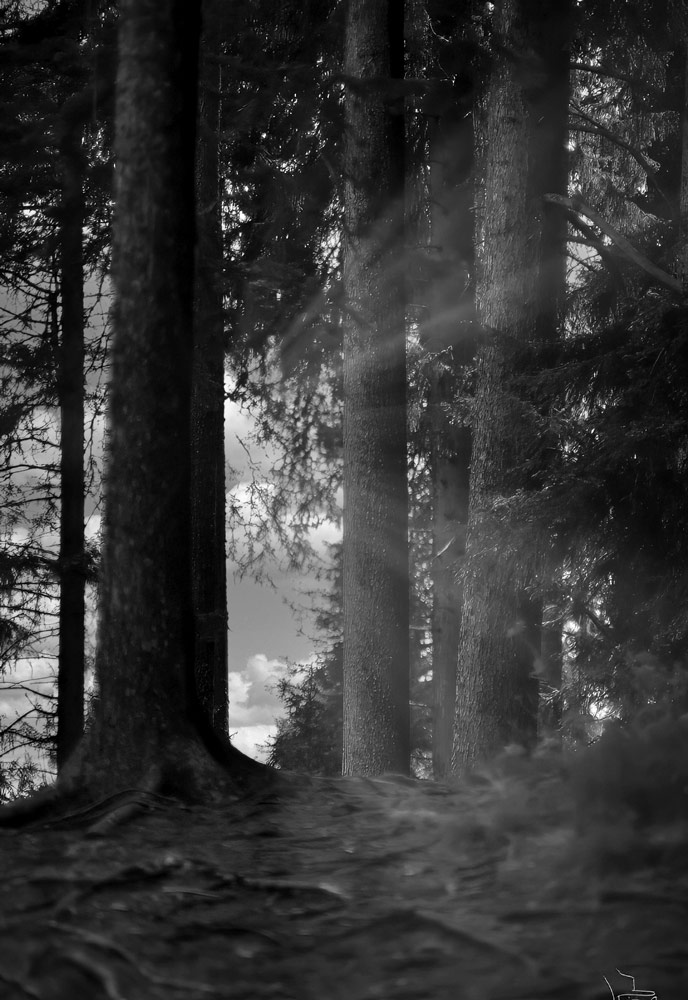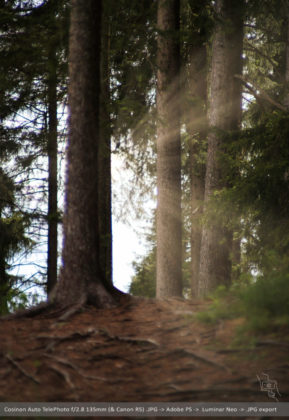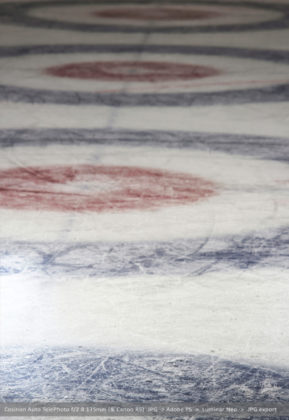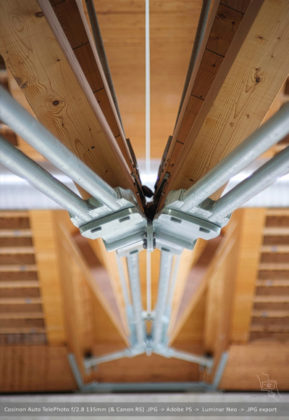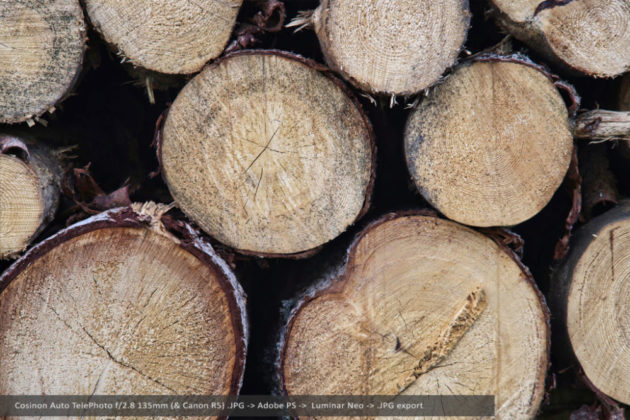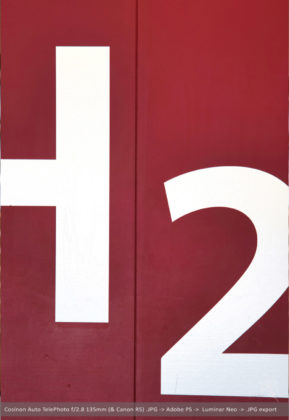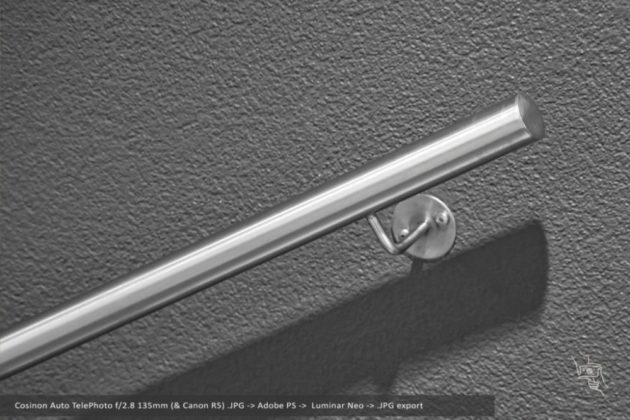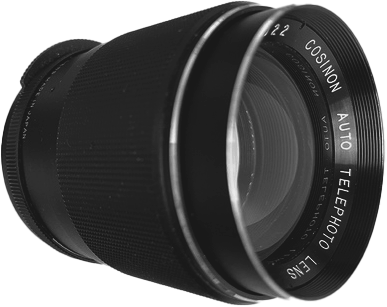Lens overview
Sold under the Cosinon brand in the late 1970s/1980s, this 135/2.8 was manufactured in Japan by Cosina—the prolific OEM behind a long list of third‑party and re‑branded lenses. You’ll encounter the lens in several mounts (most commonly M42 and Pentax K, with occasional variants in other SLR mounts; here, a M42 variant), typically with multi‑coating and “Auto” diaphragm linkages. Typical specs across the family: f/2.8–22 (some f/16), 6‑blade diaphragm, minimum focus 1.5–1.8 m, 55 mm filter (some K‑mount copies use 52 mm), and ~400–420 g weight. In short, it’s a compact, straightforward tele‑prime aimed at the enthusiast who wants reach without the price or heft of OEM glass.
Target group (then & now). Then: budget‑minded SLR users, students, and travelers. Now: mirrorless shooters looking for an inexpensive and fun portrait / compressed‑perspective lens, film users who want a reliable tele, and anyone who enjoys the manual‑focus experience.
Pricing today. One of the big attractions: clean copies typically sell for €20–60 / US $20–70 depending on mount and condition; dealer examples sometimes dip below €25. For what it does, it’s a true bang‑for‑buck.
Build and ergonomics
It’s metal‑barrel simple: a rubberized (or knurled, on earlier copies) focus ring with a comfortable throw, positive aperture clicks, and a front that doesn’t rotate—easy with polarizers. Most copies use 55 mm filters; some K‑mount versions use 52 mm filters. Balance is excellent on small mirrorless bodies with an adapter. A few versions include a built‑in retractable hood; if yours doesn’t, bring a short tele hood to help with low‑angle sun.
Optical performance
Sharpness & contrast. Usable in the center at f/2.8, and noticeably better by f/4–5.6, with the whole frame nicely consistent around f/8. Expect a classic tele look rather than clinical perfection. Sample condition matters: haze or decentering can dull the image—buy clean glass.
Bokeh & rendering. With 6 blades, out‑of‑focus highlights stop‑down to hexagons, but at f/2.8–4 the background melt is pleasing for portraits and detail shots. Compression at 135 mm does most of the separation; the lens doesn’t add nervousness or swirl—just a gentle fall‑off.
Color, flare & CA. Coatings are competent for the era; contrast holds under soft backlight, but veiling flare appears if the sun is just out of frame—use a hood. Expect moderate axial CA at f/2.8 on hard edges (chrome, hairlines against bright sky), which drops quickly by f/4–5.6 and is easy to clean with standard Remove CA / Defringe tools. Lateral CA is mild.
Distortion & vignetting. Geometric distortion is negligible; vignetting is light at f/2.8 and gone mainly by f/4–5.6.
Digital adaptation (today’s bodies)
- Mirrorless (RF / Z / E / L / X): Adapts perfectly with a simple glass‑less ring (choose the ring that matches your lens mount). You’ll keep infinity focus and control aperture on the lens. On IBIS bodies, set 135 mm for stabilization.
- Canon EF DSLRs: M42→EF adapters are easy and keep infinity; Pentax K→EF and several other SLR mounts do not reach infinity without optics—better to go mirrorless or choose an M42 copy if you’re staying in EF land.
- Nikon F DSLRs: If you have a Non‑AI F‑mount variant, confirm compatibility; older Non‑AI lenses can foul some AI‑tab bodies. On Nikon Z, a simple F→Z ring solves it.
Historical and collector context
Cosina produced enormous volumes of value‑oriented lenses, often selling the same optical core with different cosmetics and brand names. This Cosinon-T 135 mm f/2.8 / Cosinon Auto MC 135 mm f/2.8 line sits in that tradition: a reliable, budget tele that filled countless camera bags in the film era and now finds a second life on mirrorless. Collectors don’t chase it—shooters do. Expect multiple cosmetic versions (all‑metal focus rings on earlier “Auto” copies, rubber grips on later “MC” copies; Cosinon‑T labels show up too), minor optical variations, and mount‑specific differences in filter thread (52 mm vs 55 mm). That variety is part of the charm.
Impressions
Treat f/4–5.6 as the working aperture for portraits and compressed scenes; use f/2.8 for a touch of glow on highlights or when light is scarce. The long minimum focus (1.5–1.8 m) isn’t for tight macro, but it’s perfect for head‑and‑shoulders distance, street details at standoff range, and casual wildlife in good light. It’s a fun lens because it’s uncomplicated: one focal length, one solid feel, and clean results that look great with a quick contrast curve. Pair it with a beanbag or monopod if you’re living at 1/125–1/250 s; otherwise, lean on IBIS and a hood.
Modern comparison
A modern 135 mm telephoto will, of course, outperform the Cosinon technically—sharper corners, faster focus, better coatings—but it also weighs and costs exponentially more. Among vintage peers, most f/2.8 135 mm designs share similar optical personalities: a pleasant, slightly soft wide-open look that cleans up beautifully by f/4–5.6.
Within that vintage crowd, Cosina’s Cosinon 135 mm stands shoulder-to-shoulder with other respected Japanese telephotos such as the Auto Mamiya-Sekor 135 mm f/2.8 CS and its earlier Mamiya-Sekor 135 mm siblings. The Mamiya lenses tend to show a touch more contrast and refinement, but they’re harder to adapt to mirrorless systems due to their proprietary mounts, and typically cost more on the second-hand market.
The Cosinon’s advantage is practical: it’s easy to find, easy to adapt, and consistent. If you need closer focus or premium “pop,” you step up to pricier 135s; if you want simple, cheap, and cheerful, this one nails it.
Sample photos
Verdict — Pros and Cons
Pros
• Made in Japan; compact and well‑balanced
• Pleasant rendering with good results by f/4–5.6
• Negligible distortion; easy mirrorless adaptation; 55 mm (sometimes 52 mm) filters
• Very affordable on today’s market—a low‑risk way to learn a 135 mm
Cons
• 1.5–1.8 m minimum focus is long for tight close‑ups
• 6‑blade iris gives geometric highlights when stopped down
• Moderate LoCA at f/2.8; flare if you shoot near the sun without a hood
• Quality varies with sample condition (haze, decentering on some copies)


